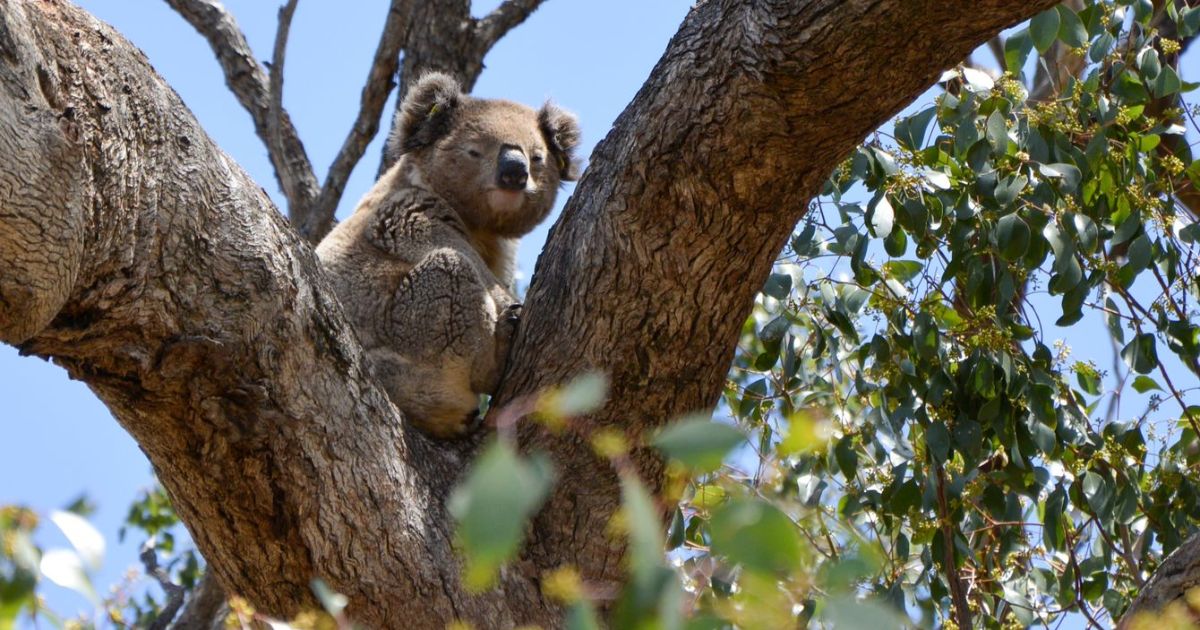Koala
Phascolarctos cinereus
Status
Endangered
Habitat
Found in a range of temperate, sub-tropical and tropical forests, woodland and semi-arid communities that are dominated by Eucalypts. Although usually solitary animals, koalas individual home ranges overlap extensively.
The size of each koala's range depends on the quality of habitat. Home ranges vary from 1 to 2 ha in high quality habitat to 100 ha in semiarid areas. Within healthy forest on good soil and with adequate moisture, breeding females often dominate better quality habitat so energy is conserved when rearing young, whilst males are often pushed into poorer quality habitat.
Under most conditions, koalas move between trees a few times each day. Dispersing individuals, mostly young males, may cover distances of 10km.
Behaviour
They are generally solitary, spending most of the day sleeping and foraging and moving mostly at night.
Diet
The koala’s diet consists of about 70 eucalypt species and 30 non-eucalypt species. Koalas have a specialised digestive system to break down and
absorb nutrients from the large quantities of leaves they consume.
Breeding
The koala breeding season is between October to May. When breeding, males call with loud bellowing and snarling coughs. Koalas produce only one young per year.

Why are koalas threatened?
- Loss and fragmentation of habitat
- Predation or attack from wild and domestic dogs as well as livestock such as cattle and horses
- Low genetic diversity in isolated populations
- Mortality due to vehicle collision, malnutrition and dehydration, drought, heat waves, and fire
- Disease including chlamydia.
Protecting koalas and their habitats
It is vitally important for communities across NSW to protect and enhance koala habitat through on-ground works and surveys to learn more about how we can protect koala populations.
Local Land Services is partnering with Landcare to deliver funding under the NSW Koala Strategy to support the recovery of the endangered Koala populations located in the Southern Tablelands and Monaro.
In the North West, the area between Carroll and Gunnedah adjacent to the Namoi River has been identified as an area that will be important for koala populations in a changing climate due to proximity to permanent water and existing remnant native vegetation. Enhancing these areas by reducing weeds, and revegetation along TSRs and private land will give the koala population the best chance of survival and recovery.
Habitat and Wildlife Recovery Project
Following bushfire habitat loss, funding was offered to landholders for a range of on-ground works including tree planting, weed & pest animal control, fencing and erosion control works to address processes that threaten the habitat of koalas and other threatened species as part of the Australian Government’s Regional Fund for Wildlife and Habitat Bushfire Recovery.
Protecting the Rockley Mount population (Bathurst)
Through funding provided by the Australian Government’s Koala Community Grants, Central Tablelands Local Land Services is collaborating with several key stakeholders to gain greater insight and understanding of the koala population around the Rockley Mount district.
The Rockley Mount koala population is known to be the largest population in the Bathurst region, yet there is little knowledge about the population size or extent.
How you can help our koalas
If you've keen a koala, report your sightings.
Since the decline of koalas in North West slopes region, it has become very important to survey the slopes area to find out more about these koala populations, their health status and the type of vegetation being utilised. Reporting public sightings of koalas will help identify locations to conduct koala scat surveys using a detector dog over spring and summer 2022-23. This information will help direct future investment to protect any populations found.
In conjunction with Forestry Corporation, Central Tablelands Local Land Services is undertaking monitoring to inform environmental managers, land managers and the community about koala numbers, distribution and habitat. Of particular interest are sightings in the Copperhania Nature Reserve and Roseberg and Pennsylvania State Forests.
Report koala sightings via the I Spy Koala app.
If you live on the North Coast, consider applying for the Koala Project EOI, open until August 1, 2023
How to make a koala friendly backyard
- Fences can either be used to include or exclude koalas; choosing a koala friendly fence makes sure that the koalas maintain access to their home range.
- Dogs should be tied up or kept inside at night; koalas are most active at night and most likely to be attacked during this time. Even the friendliest dogs have been known to cause injury to koalas.
- Report roaming dogs to your local animal control to reduce attacks on koalas.
- Plant koala friendly trees (find out more from your Local Land Services team).
- Control cactus weeds, especially tiger pear that can incapacitate a koala.
- Provide water for koalas particularly during summer in shallow dishes at the base of trees and away from dogs.
- Leave koalas alone; koalas are easily stressed by too much attention from humans and dogs.
More information
Contact Angela Baker, Senior Land Services officer in Gunnedah on angela.baker@lls.nsw.gov.au
Kirrily Gould, South East Land Services officer Kirrily.gould@lls.nsw.gov.au
Mid North Coast & Hunter Koala Factsheet PDF, 2153.73 KB.
Koalas in Backyards PDF, 2666.89 KB.
Providing water for koalas PDF, 9540.46 KB.
Learn more about natural resource management and how you can help protect threatened species in NSW.